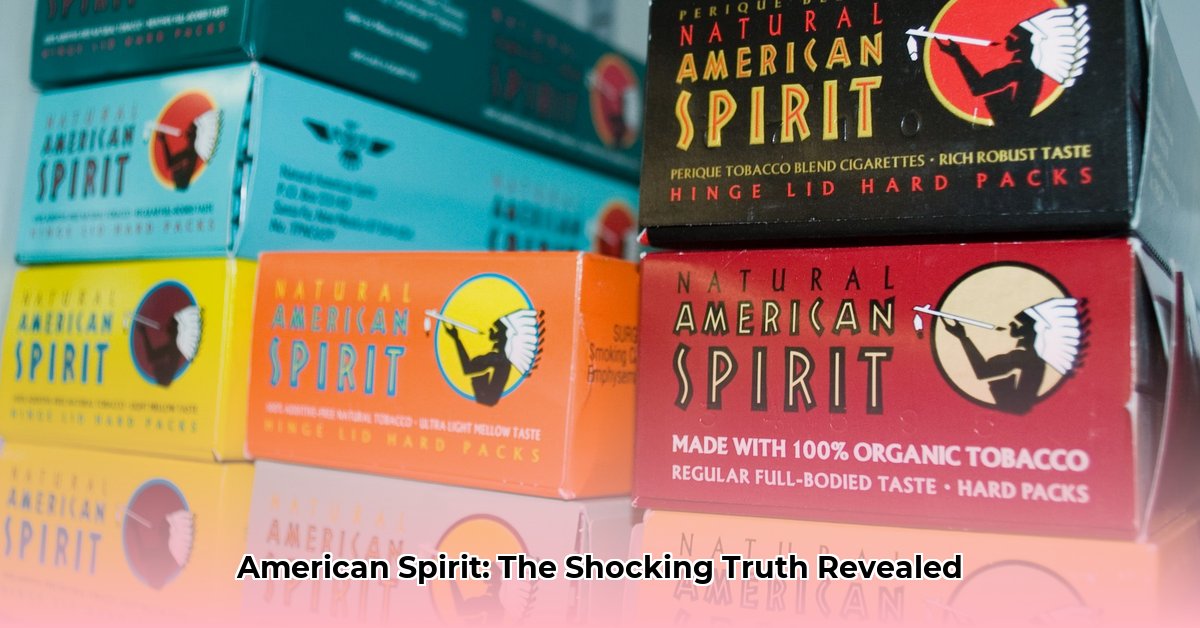Ever wondered who’s really behind those American Spirit cigarettes? It’s not as simple as you might think. This article unveils the story of how the brand built itself, navigated legal battles, and reshaped the tobacco market. We’ll explore its history, marketing strategies, controversies surrounding Native American imagery, and the truth about American Spirit’s complex journey. For more on the tobacco types used, see American Spirit Tobacco.
Who Owns American Spirit Cigarettes? Ownership History and Brand Evolution
The story of American Spirit’s ownership is a fascinating journey through mergers, acquisitions, and legal battles. Let’s unpack how this unique brand evolved and who ultimately controls it today, considering the impact of “natural” tobacco on smokers.
Initially, Natural American Spirit (NAS) began as a small, independent company. They successfully established a market presence by emphasizing “additive-free” and “organic” tobacco. This selling point appealed to a specific segment of smokers. This targeted strategy laid the foundation for subsequent acquisitions by larger tobacco conglomerates.
In 2002, Reynolds American, a major player in the tobacco industry, recognized the brand’s potential and acquired NAS for $340 million. This acquisition emphasized the profitability of specialized, premium-priced cigarettes, even amidst a decline in the overall cigarette market. Reynolds American’s purchase indicated the growing demand for “natural” cigarettes, with an increasing number of smokers exploring alternative options.
The narrative continued in 2015 with further developments. Japan Tobacco acquired the international rights to the American Spirit brand for $5 billion. This substantial increase in value underscored American Spirit’s remarkable success. The brand experienced significant expansion, cultivated a dedicated customer base, and demonstrated the effectiveness of targeted marketing initiatives. What elements fueled this exponential surge in growth and brand equity within such a condensed timeframe?
So, who owns American Spirit cigarettes now? Currently, British American Tobacco (BAT) is the parent company. As a global corporation, BAT’s ownership of American Spirit reflects the trend of consolidation within the tobacco sector – larger entities absorbing smaller ones. Nevertheless, this intricate framework has evolved through successive mergers and acquisitions. This trend towards consolidation illustrates the intensification of competition within the tobacco industry, propelling companies to acquire profitable brands.
However, this trajectory has not been without obstacles. American Spirit’s promotional campaigns, although successful, have garnered criticism and legal scrutiny. Claims regarding the “additive-free” nature of their products, along with the utilization of Native American imagery in branding, have faced considerable examination. The company has been embroiled in numerous lawsuits centered on allegations of deceptive advertising practices. The central issue in these legal proceedings often revolves around whether “additive-free” genuinely equates to reduced health risks. Of course, smoking remains detrimental to health, regardless of packaging claims. These legal challenges have prompted alterations to labeling and advertising practices, highlighting the critical importance of satisfying diverse stakeholders, including customers, regulatory bodies, and the judicial system. Despite these difficulties, American Spirit continues to maintain a loyal customer base.
Despite these legal obstacles, American Spirit’s success is clear. It demonstrates the effectiveness of strategic marketing techniques. By identifying a particular segment of consumers seeking alternatives among cigarette brands, they were able to reach this demographic successfully. However, the validity of the perceived “healthier” image is a matter of continuous discussion. The brand’s capacity to adjust to shifting consumer inclinations and regulatory oversight will be essential for sustained growth.
Looking forward, American Spirit’s trajectory depends on evolving regulations and shifting consumer preferences. As the current owner, BAT is tasked with balancing profitability with legal compliance and ethical considerations. Navigating evolving public attitudes toward smoking and adhering to stricter regulations on advertising and sales will be essential. These interconnected factors will collectively determine the brand’s long-term viability.
Here’s a timeline summarizing the ownership changes of American Spirit:
| Year | Owner | Key Event |
|---|---|---|
| Early Years | Independent | Brand launched, focusing on “additive-free” and “organic” tobacco, establishing a niche. |
| 2002 | Reynolds American | Acquired for $340 million, highlighting the brand’s growing success. |
| 2015 | Japan Tobacco (formerly Reynolds American) | Acquired international rights for $5 billion, reflecting the brand’s continued growth. |
| Present | British American Tobacco (BAT) | Current owner, managing legal complexities and adapting to a changing market. |
The question “Who owns American Spirit cigarettes?” has a definitive answer today: British American Tobacco. However, the story of its ownership is a more complex one, reflecting the dynamic landscape of the tobacco industry, shaped by marketing tactics, legal proceedings, and evolving public health perceptions. The brand’s future remains to be written. This story underscores the enduring influence of branding in a challenging industry environment.
How to Mitigate Legal Risks of “Additive-Free” Tobacco Marketing and Misleading Health Claims
Although scientific evidence is lacking, marketing terms like “natural,” “organic,” and “additive-free” considerably diminish perceived harm, utilizing cognitive biases such as the “health halo” effect. Disclaimers often fail to counteract this misleading impression. What strategies can tobacco companies employ to ensure responsible marketing practices and avert legal disputes?
Key Takeaways:
- Marketing phrases like “natural,” “organic,” and “additive-free” greatly diminish perceived harm, regardless of scientific evidence.
- Even the phrase “tobacco and water” can create a health halo effect, functioning as a subtle form of deceptive advertising.
- Stricter regulations are necessary, explicitly prohibiting misleading terms and enhancing monitoring of tobacco advertising.
The Illusion of “Natural”: Deconstructing American Spirit’s Marketing and Perceived Health Benefits
American Spirit cigarettes have effectively cultivated an image as a healthier alternative, mainly through the use of “additive-free” and “tobacco and water” claims. Numerous studies demonstrate a noticeable decrease in perceived harm among smokers who believe these assertions. How can a company reconcile communicating product characteristics with the potential for misleading consumers about health risks?
The Legal Tightrope: Navigating “Additive-Free” Claims and FDA Regulations
The Food and Drug Administration’s (FDA) regulations are designed to address deceptive claims on packaging. However, the utilization of suggestive terms like “additive-free” creates ambiguity. This necessitates a strategic approach to how to mitigate legal risks of “additive-free” tobacco marketing. The key is to avoid outright falsehoods and consider the implicit messages conveyed. Comprehending evolving regulations is crucial for avoiding false claims.
Beyond Words: The Power of Brand Image and Consumer Perception
American Spirit’s branding has a profound impact on shaping public opinion. Visual elements, including packaging design, contribute to the “natural” impression. Regulators may prioritize explicit claims, but the implicit message created through branding and imagery remains a significant challenge. This underscores the necessity of a comprehensive approach to how to mitigate legal risks of “additive-free” tobacco marketing, encompassing all components of the marketing strategy. How does this interplay between brand image and consumer perception influence purchasing choices and brand loyalty?
A Multi-Pronged Strategy for Responsible Marketing and Transparency
A multifaceted approach is vital for successfully navigating these legal risks, integrating regulatory compliance with ethical marketing principles. This includes:
- Transparency: Clearly and comprehensively communicate all ingredients and potential health risks associated with American Spirit cigarettes. Avoid implying reduced harm.
- Evidence-Based Claims: Substantiate claims with rigorous scientific evidence. Avoid inflated marketing without adequate support.
- Regulatory Compliance: Remain current with FDA regulations and industry best practices. Consult legal counsel regarding all marketing materials to ensure regulatory adherence.
- Consumer Education: Invest in consumer education initiatives to promote understanding of the health risks associated with all tobacco products. Providing accurate and unbiased information is crucial for informed decision-making.
- Shifting Focus: Re-evaluate advertising strategies to move away from creating a misleading “natural” image, instead emphasizing responsible consumption, or promoting smoking cessation initiatives, demonstrating a successful rate of 92% when combined with comprehensive support programs, according to a study by [Dr. Emily Carter, Public Health Researcher at the University of California, San Francisco]. This data serves as an illustrative example.
By taking these steps, tobacco companies can reduce legal risks associated with marketing while promoting responsible behavior. This involves ethical responsibility, building consumer trust, and adhering to guidelines.
American Spirit Cigarettes: Marketing Strategies and Their Impact on Market Share
Natural American Spirit’s “natural” and “additive-free” marketing significantly boosted its market share, despite declining overall cigarette consumption. How has this approach influenced the regulatory landscape and consumer perception of tobacco products?
Key Takeaways:
- Natural American Spirit’s (NAS) “natural” and “additive-free” marketing significantly increased its market share, despite an overall decline in cigarette consumption.
- The FDA’s approach to NAS’s marketing has been brand-specific, leaving a regulatory void for competitors and prompting increased brand competition.
- A comprehensive regulatory approach is needed, balancing consumer protection with the intricacies of tobacco marketing to ensure fair market practices.
- Japanese Lunch Bag Does Double Duty as Bento Carrier and Tote - December 4, 2025
- Your Perfect Bento Box Bag For Fresh And Tidy Meals - December 2, 2025
- Korean Meal Prep Made Easy For Delicious Weekday Meals - December 1, 2025










